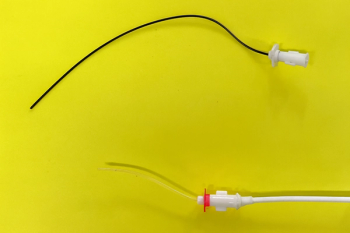
Crystals, stones, and diets (Proceedings)
There are many misconceptions regarding the significance of crystals found on routine urine sediment examination in dogs and cats. There is a large amount of information about the impact of diet, water intake, urine handling, breed, and many other possible contributing factors on the formation of crystals and stones.
Important points:
• Examination of a fresh urine sample within minutes of collection and before refrigeration will greatly reduce the formation of crystals during storage and transport and thus reduce misinterpretation of a urine sediment.
• The higher the urine concentration (specific gravity), the more likely crystals are to form
• The lower the temperature of the urine, the more likely crystals are to form
• The lower the concentration of inhibitor substances, the more likely crystals are to form
• The higher the excretion of calculogenic substances, the more likely crystals are to form
• pH can have an impact in the formation of SOME BUT NOT ALL crystals
There are many misconceptions regarding the significance of crystals found on routine urine sediment examination in dogs and cats. There is a large amount of information about the impact of diet, water intake, urine handling, breed, and many other possible contributing factors on the formation of crystals and stones. The purpose of this discussion is to try to cut through the information down to what we know, what we don't know, and what is "veterinary urban legend".
The precipitation of mineral (calcium oxalate, struvite, urate, cystine) into crystals or stones depends on many factors including the degree of urine saturation with the particular crystalloid, the presence or lack of promoters and inhibitors of precipitation, the diet, the pH of the urine (in some but not all cases), and volume of the urine.
Crystals – general information
• Form in concentrated urine (even at neutral pH)
• Are dependent on urine pH and temperature as well as osmolality
• Not necessarily pathogenic
• Do not necessarily show up in cats and dogs with stones
• Do not mean that a cat or dog will be a stone former
• Can occur ex vivo in refrigerated urine or if it evaporates. Crystals formed in this manner are not clinically significant.
• Crystals that form while urine is in the refrigerator do not necessarily dissolve if the urine is warmed back up to room/body temperature
Stones – general information
• Pathogenic
• More likely to form in concentrated urine
• Animals with stones do not always have crystals in their urine, or even crystals of the same type
• Some animals are chronic stone formers and may form different types of stones during their life (usu. struvite and calcium oxalate)
• May require dietary management to prevent recurrence
When are crystals a problem?
• If seen in a patient who is a known stone-former
• Patient with lower urinary tract signs
• Male cat with history of plug formation/obstruction
• Persistent, significant crystalluria noted on a fresh urine sample
Struvite
Used to be the most common type of stone in both dogs and cats, now appears to be similar in frequency to calcium oxalate in both species
Struvite is less soluble in pH > 6.7 which is why we see struvite stones and crystals in alkaline urine
In dogs usually associated with UTI of Staph. or Proteus sp. which hydrolyze urea and leads to alkaline urine
Unlike dogs, most struvite stones in cats between 1-10 years of age are not associated with a UTI
Struvite stones can be dissolved medically by exclusively feeding a specially designed acidifying, low protein diet (Hills' Prescription Feline or Canine s/d)
It is important to treat dogs with antibiotics or monitor for UTI during the dissolution process since bacterial infection will prevent adequate acidification of the urine
Diet parameters for Struvite
• Increased water intake (canned?)
• Decreased in phosphorus
• Decreased Mg
• Moderately acidifying (pH 6.0 – 6.3)
• Lower carbohydrate content
• +/- Higher in protein content (works as an acidifier, but may increase ammonium in urine)
Dissolution
• Hill's Prescription Diet Feline s/d
Prevention
• Royal Canin Urinary SO
• Royal Canin Control Formula-
• Purina UR St/Ox
• Purina UR
• Science Diet c/d Multicare
• Iams Low pH/S
Calcium oxalate
Urine is oversaturated with calcium and oxalate
Formation is inhibited by nephrocalcin, uropontin, and Tamm-Horsfall proteins in the urine (inhibit combination of Ca and oxalate)
Increased urinary citrate (and Mg and pyrophosphate) can combine with calcium and oxalic acid (soluble) and reduce CaOx (insoluble) production
Hypercalcemia can predispose to hypercalciuria
Urine pH itself has little direct effect on the formation of the CaOx crystals, but in patients who produce acidic urine (pH< 6.2), more calcium is excreted (possible due to increased buffering of bone) and crystal inhibitors may be negatively affected
Thus, metabolic acidosis can predispose to hypercalciuria (which may occur with very acidifying diets) – bone turnover
Oxalate can be absorbed from the GI tract
Oxalic acid is an end product of ascorbic acid metabolism (Vitamin C)
Vitamin B6 deficiency can increase urinary oxalate levels
Treatment
• CaOx uroliths cannot be medically dissolved
• After removal of stones a program of reduction in urinary calcium and oxalate, decreased specific gravity, and stone surveillance needs to be put into place
Diet parameters for CaOx
• Increased water intake (canned?)
• Non-acidifying (aims for a pH 6.5 – 7)
• Adequate phosphorus
• Adequate Mg
• Adequate Vitamin B6
• Supplemented with citrate (+/-)
• Avoid high protein, high Ca, high Oxalate, high Na diets
• Hill's Prescription Diet c/d Multicare
• Hill's Prescription Diet x/d (?)
• Royal Canin Urinary S/O
• Iams Moderate pH/O
• Potassium citrate?
Urate
Associated with hepatic dysfunction, portosystemic shunts (PSS), or dysfunction of the metabolism of uric acid in dogs
Cats only rarely have an underlying metabolic disorder associated with urate stones
Dalmatian, English Bulldog, breeds predisposed to PSS
Males > females, likely due to increased incidence of urinary obstruction in males
Treatment
• Low purine (low protein) diets may reduce recurrence as well as assist in dissolution on dogs (Hill's u/d). Monitor for protein defects and supplement carnitine in English Bulldogs. Medical dissolution does not appear to work well in cats.
• Allopurinol is a competitive inhibitor of xanthine oxidase which converts hypoxanthine to uric acid in 2 steps. A low purine diet must be fed at the same time as allopurinol is used to prevent xanthine stone formation. Other adverse effects are uncommon.
• 15 mg/kg PO q 12h for dissolution, 5-10 mg/kg PO q 12h for prevention
Cystine
Very rare in cats, uncommon in dogs
Breed predispositions: DSH and Siamese cats, male dogs, Newfoundlands, Dachshunds, Bassets, English bulldogs, Yorkshire terriers, Chihuahuas, bull mastiffs, Rottweilers, many others identified
Defect in renal tubular transport of cystine, orinthine, lysine, and arginine (COLA) amino acids (shared transporter) in the proximal tubule
More likely to precipitate in acidic urine
Treatment
• Medical dissolution may work in dogs, but not in cats – Hill's u/d
• Alkalinize urine – potassium citrate
• 2-MPG converts cystine to a more soluble compound, GI side effects common
• 15-20 mg/kg PO q12h for dissolution, use low end of dose with food for prevention
• D-penicillimine – more toxicity reported, mainly GI
• 15 mg/kg PO q 12h with food
• Frequent relapse, need to keep on u/d diet, alkaline urine
General treatment guidelines
The number one thing regardless of crystal/stone type is to reduce urine specific gravity! Preferably < 1.030
Increase water intake
• Canned food
• Fountains
• Flavored water
• More water sources
• Salting food is controversial
Monitor Urine pH
• Fresh Sample
• Monitor for recurrence of stones
Treat crystalluria only if neededDissolution diets will not work unless the owner feeds them exclusively
It is important to implement a stone surveillance program in dogs and cats that are chronic stone formers to allow detection and potential voiding urohydropulsion of new stones before they become surgical. This involves monitoring urinalysis to keep pH and specific gravity levels in check, radiographs q 2-3 months, and watching for UTIs.
Common misconceptions
• Crystals always need to be treated when seen on a urinalysis – Only if the patient is a chronic stone former or a male cat at risk of obstructing. A fresh urine sediment needs to be examined to confirm the presence of crystals. Struvite and Ca Ox crystals can form in normal urine, especially if it is very concentrated. Crystals in and of themselves are not a pathologic process and in cats, are not necessarily a contributor to lower urinary tract signs. They may be, however, a signal that the cat's urine is very concentrated, and thus may be at risk for lower urinary tract problems.
• Diet is the only way to manage crystals and stones – not entirely true. Increasing water intake is one of the most important things that can be done in patients who are stone formers to reduce the saturation of the urine. Simply switching diets alone may not do the trick.
• Dogs and cats who form one type of stone will generally only form that type of stone – In fact, many of these animals will form struvite stones once, then form CaOx stones the next time.
• All cats should start out on an acidifying diet – this may actually exacerbate the propensity for CaOx stone formation. The growth of acidifying diets on the pet food market may have contributed to the rise in CaOx stones over the last 20 years.
• Stone analysis is not always necessary – While we can often make an educated guess regarding the type of stone, it is still important to have the stone analyzed so that appropriate therapy can be instituted. There is little excuse not to analyze the stone when the Minnesota Urolith Center does it at NO CHARGE if you provide history on the patient. The client only has to cover the shipping costs.
• Calcium Oxalate stones can be dissolved – not true. These stones must be removed by surgery, voiding urohydropulsion, or lithotripsy.
References
Chew DJ, DiBartola SP, Schenck PA. Canine and Feline Nephrology and Urology, 2nd ed. Elsevier, St. Louis, MO, 2010.
Osborne CA, Lulich JP, Forrester D, Albasan H. Paradigm changes in the role of nutrition for the management of canine and feline urolithiasis. Vet Clin North Am Small Anim Pract. (2009) 39(1):127-41.
Newsletter
From exam room tips to practice management insights, get trusted veterinary news delivered straight to your inbox—subscribe to dvm360.





